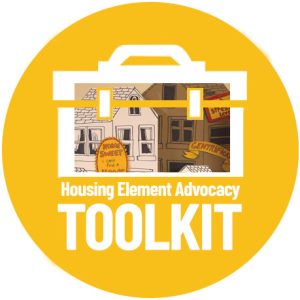Housing Element Advocacy
Under California law, every eight years cities and counties are required to develop local affordable housing action plans called the “Housing Element.” The Housing Element must identify land where new affordable housing can be built and commit to a concrete “program of actions” to meet the housing needs of the community at all income levels. These actions are designed to make sure that low-income families can find an affordable place to call home in every community, promoting economic and environmental sustainability throughout the region.
Throughout the Bay Area, cities and counties are updating their Housing Elements to accommodate the region’s new housing needs—especially for low-income households. Thanks to the 2018 fair housing law Public Advocates co-sponsored, which requires cities to take proactive steps to remedy exclusionary housing policies, these jurisdictions must also adopt comprehensive policies that will advance housing justice for people of color, immigrants, people with disabilities, and other groups that are legally protected from discrimination.
Public Advocates has worked for nearly twenty years to implement, enforce, and strengthen the Housing Element law. Through state legislative advocacy, precedent setting litigation, and local and regional coalition work in the Bay Area, we are committed to making the law’s promise of adequate affordable housing in every community a reality.
We currently convene a working group of Bay Area advocates working to make sure that all cities and counties in the region adopt Housing Elements that respond to the most pressing needs of low-income residents. Read more about this campaign at www.housingelementtools.org.
Throughout the Bay Area, cities and counties are updating their Housing Elements to accommodate the region’s new housing needs—especially for low-income households. Thanks to the 2018 fair housing law Public Advocates co-sponsored which requires cities to take proactive steps to remedy exclusionary housing policies, these jurisdictions must also adopt comprehensive policies that will advance housing justice for people of color, immigrants, people with disabilities, and other groups that are legally protected from discrimination. The Housing Element update process, which occurs once every eight years, provides local housing justice advocates a unique opportunity to create policies that address local priorities. Some examples include:
- tenant protections
- exclusionary zoning
- affordable housing funding
- preserving affordable housing through tenant and community opportunity to purchase policies (TOPA/COPA)
We have a long history of enforcing and strengthening Housing Element requirements through both litigation and coalition work, including:
- 2020 – 2021 victory for equitable Regional Housing Needs Allocation in the Bay Area
- 2018 California passes “Affirmatively Furthering Fair Housing” law
- 2017 California strengthens requirements that housing elements identify high quality sites for affordable housing, AB1397(Low) and replace affordable housing sites that develop with other uses, SB166(Skinner)
- 2012 settlement of Peninsula Interfaith Action v. City of Menlo Park
- 2011-2012 support to local housing advocates in the City of Alameda ends 39 year ban on multi-family development
- 2011 creation of the OneBayArea Grant Program ties local infrastructure money to housing element adoption
- 2010 settlement of Urban Habitat v. City of Pleasanton
- Ongoing work on individual Housing Elements spanning the Bay Area from Gilroy to Pittsburg, Palo Alto to Marin
Learn more about our work by clicking on the map below:


